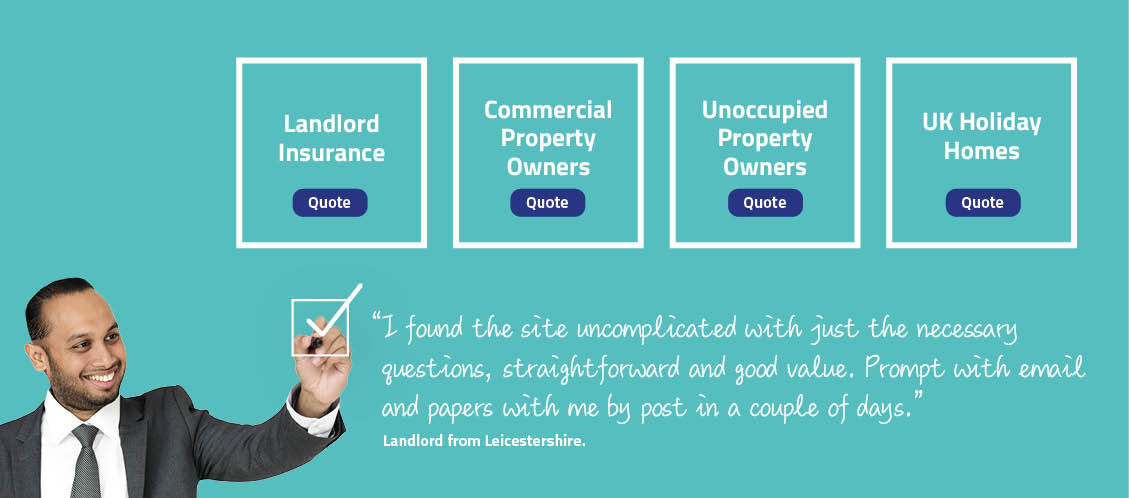When you acquire a buy to let property, your main focus may be on the fact that is in an asset that may contribute to a comfortable retirement for you. Or perhaps it is nest egg that you hope may help to fund your children through university or get them onto the property ladder?
While it is exciting making plans and potentially watching your investment work hard for you, it is important not to forget the less ‘glamorous’ side of being a landlord and arranging things such as your buildings insurance for landlords. It may be a very important part of protecting your precious asset.
Rather than seeing let property cover as just another bill to pay, you may wish to bear in mind that having landlords insurance may be necessary to:
- abide by the terms of your mortgage;
- and protect your own pocket.
Your mortgage agreement may require you to have landlord buildings insurance
If you have a loan secured on the buy to let property, it may be a condition of that mortgage that you arrange suitable buildings insurance for landlords. This protects both your and their financial interests in the property.
For example, if the property is uninsured and goes up in smoke, the lender would be left with virtually nothing to provide security for the loan. And you would be left making monthly mortgage payments for a property that no longer existed.
Landlord’s building insurance is designed to step in and pay the costs (up to the agreed sum insured) to rebuild your property.
When you took out the mortgage, the valuation you had done may have specified a sum insured required for the purposes of buildings insurance. Note that this amount may typically include the costs of clearing the land, should the property be completely razed to the ground. See our section on this further down the page: What is the buildings sum insured?
What does buildings insurance cover?
Just about any buildings insurance (whether owner-occupier home insurance; landlords insurance; or unoccupied property insurance) typically covers the structure of the building (so walls, roof etc) as well as the fixtures and fittings.
The fixtures and fittings are things like fitted kitchens, built in wardrobes etc – basically, anything that would be left inside your property if you turned it upside and shook the contents out!
A basic buildings insurance policy may typically include some or all of the following elements of protection:
- damage to your property from events such as flooding, fire and smoke, storms and earthquakes;
- theft and vandalism.
What it is important to note is that the hazards covered by a policy may vary, depending on the insurer. For example, subsidence forms a standard part of all of our landlords insurance policies. Some other companies, however, do not include this cover as standard, and they will charge you to have this element of protection included if you want it. (This also applies to many owner-occupier policies too, so always check the cover).
Your needs for landlords’ insurance will depend upon your individual circumstances. What you consider a good landlord insurance policy, therefore, may provide you with financial protection against the following (either as standard part of the cover or as an optional pay-for add-on):
- damage to the structure of your building;
- damage or destruction of your fixtures and fittings;
- ditto for the contents plus their theft (see next section: Buildings contents insurance);
- third party public liability claims;
- loss of rent cover (where this arises from an insured risk). This is where, should your tenants have to move out of your property following an insured event (such as a fire or flooding) you will receive up to a pre-agreed sum from us in lieu of your lost rent;
- some forms of legal fees (again, if they relate to an insured risk);
- malicious damage caused by tenants;
- trace and access cover.
Typically, a policy won’t always cover things such as tenants that depart suddenly leaving large rent arrears or tenants that you’re trying to evict. So, if you incur legal expenses in either situation and/or an associated loss of rental income, your policy typically won’t cover it.
Buildings contents insurance
You may also require buildings contents insurance if your let property is furnished or has communal, furnished areas (such as in an HMO). Speak to us if you are unsure as to what level of cover you require.
Typically, every sensible landlord wants the protection of insurance and equally typically, and no doubt you will be looking for what you consider is good value landlord building insurance that offers the most appropriate cover for you.
If you would like further clarification on what our let property buildings insurance policies cover, please feel free to get in touch.
Will my landlords’ contents insurance cover my tenant’s belongings?
No, it will not.
This is an occasional area of misunderstanding that can easily catch out both landlords and tenants alike.
In reality, landlords’ buildings and contents insurance exists to protect the interests of landlords and in some specific circumstances, third parties who might be injured or have their property damaged as a result of the landlord’s property.
So, as we discussed above, a typical landlords’ policy covering the bricks and mortar plus contents might provide cover for circumstances such as:
- damage to the building itself as well as its fittings;
- situations where the landlord’s contents, such as furniture, were destroyed by a fire or perhaps stolen in a burglary;
- instances where your tenants or another third party have sued you for damages under third party liability provisions and won their case.
However, third party liability cover typically does not include protection for the possessions of your tenants nor indeed their own physical wellbeing – unless the illness or injury was accepted by a court as being a direct consequence of something for which you were personally responsible as the landlord.
So, it might be prudent to assume that typically your landlords’ contents insurance will not cover your tenants for things including:
- the theft of their possessions following a burglary;
- the destruction of their property following something such as a fire;
- personal accidents or injuries they may sustain;
- accidents, illness or redundancy, which might prevent them from earning income and thereby paying their rent.
It’s typically a good idea to make sure these points are clarified with your tenants in advance, perhaps as part of your tenancy agreement. Special tenants’ insurance does exist and it may be in their best interests to look for it.
What is the buildings sum insured?
When applying for landlords insurance and calculating the amount of cover you need to protect your investment, you will be asked how much buildings sum insured you require.
Some landlords mistakenly believe that this amount should be equivalent to the current market value, or the amount of mortgage outstanding on the property.
However, the sum insured should actually factor in a number of different costs:
- the actual amount it would cost to rebuild your property if it was completely destroyed (note, this isn’t the market value, as already mentioned above);
- this cost should include amounts for clearing the site before rebuilding as well as the cost of fixtures and fittings (if you turned your property upside down and shook it, the stuff that didn’t fall out, such as fitted wardrobes and kitchens etc, are classed as fixture and fittings);
- professional fees etc.
In the event of a claim, if you are underinsured (i.e., your buildings sum insured amount is lower than the actual cost to re-build your property), you will be left having to find the remaining monies yourself (whilst still paying your mortgage on your property, if you have one). It’s not a good financial situation to be in.
How can I find out my rebuild value?
The amount can usually be found on your valuation report or mortgage survey. If you are still unsure of the rebuild value, use the Association of British Insurers’ rebuild calculator.
If you have any questions relating to your buildings sum insured, please feel free to get in touch. We will be more than happy to help.
What is loss of rental income cover?
If the worst happens – the property burns down or is destroyed in another manner – then the tenant will have to leave because the property is inhabitable. This means they will also stop paying rent.
Unfortunately, your mortgage would continue to fall due, so buildings insurance for landlords which includes loss of rental income cover – which can help replace loss of rent due to an insured risk – will help you keep up with your mortgage repayments until such time your property was repaired / rebuilt, and your tenant returned.
How much does buy to let insurance cost?
There are a number of things that may affect the price of your buy to let building insurance. For example, an insurer may take into account:
- the location of the property. This is relevant from the point of view of the potential risks it may face from crime and/or flooding. Given that these are issues that you are likely to have borne in mind yourself when purchasing the property, your insurer’s attitude may not come as a surprise;
- the value of the property. In this sense, the way in which prices for buy to let building insurance may be worked out may be similar to that for your owner occupied property; and
- the history of any claims that may have been made on the property. If claims have been made previously for structural issues, you may find that an insurer may want full details before being able to give you a price.
Can I get cheap buy to let insurance?
While there’s nothing necessarily wrong with that as an inclination, do remember that cheap landlord building insurance might not necessarily mean the same thing to everyone.
Some people may just say that it’s the insurance that they can get away with paying the least for. That might be fine though it may also not seem the wisest choice of definition to run with in the event of a claim if the circumstances weren’t covered.
So, in essence, what may be a cheap landlord insurance policy for you may not be the cheapest for someone else. It depends on the level of cover you need and your perceptions as to what is cheap and what isn’t.
Perhaps a more balanced definition would be a policy that met all of your needs for a cost-effective price. Using that as a guideline for buy to rent insurance may help you avoid ending up with something that’s unsuitable.
Finding the most suitable cover
Knowing that you have suitable cover behind you may help you rest a little more easily at night. That’s why finding appropriate buy to let insurance is more important than thinking exclusively about cheap landlord building insurance.
At Cover4LetProperty we provide you with an online facility to quote and buy your building and contents insurance. We provide all information regarding the insurance products we offer online, allowing you to make an informed decision based not just on our competitive premiums, but on the cover our policies provide.
Our UK building and contents insurance policies are available as:
- buildings only policies;
- buildings and contents policies;
- contents only policies.
The building and contents insurance UK policies we provide are available online where you can purchase and incept the insurance immediately.
Alternatively, don’t forget that we are also only a telephone call or email away. So, if you need a landlord’s insurance quote or simply some help and guidance on choosing buy to let buildings insurance, then we will be very happy to help. Please call us today on 01702 606 301.







